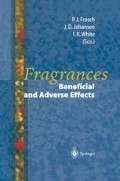Abstract
d-Limonene (Fig. 1) is a monocyclic terpene and the main constituent of oil from several fruits of the genus Citrus, and also occurs in caraway, dill and celery. Its enantiomeric form l-limonene is found, for example, in turpentine and peppermint oil.
Access this chapter
Tax calculation will be finalised at checkout
Purchases are for personal use only
Preview
Unable to display preview. Download preview PDF.
References
Opdyke DLJ (1975) Monographs on fragrance raw materials. Food Cosmet Toxicol 13 [Suppl II]: 825–826
Kirk-Othmer (1969) Encyclopedia of chemical technology, vol 19. Wiley, New York, pp 803–838
Opdyke DLJ (1976) Inhibition of sensitization reactions induced by certain aldehydes. Food Cosmet Toxicol 14:197–198
Williams AC, Barry BW (1991) Terpenes and the lipid-protein-partitioning theory of skin penetration enhancement. Pharm Res 8:17–24
Hooser SB, Beasley VR, Everitt JI (1986) Effects of an insecticidal dip containing dlimonene in the cat. J Am Vet Med Assoc 189:905–908
Karlberg A-T, Lindell B (1993) Limonene. In: Beije B, Lundberg P (eds) Criteria document from the Nordic Expert Group 1993. Arbete och Hälsa, Nordic Council of Ministers, National Institute of Occupational Health, Solna no 35, pp 207–276
Grayson DH (1990) Monoterpenoids. Natural Product Reports 7:327–347
Royals EE, Hörne Jr SE (1955) Observations on the rate of autoxidation of d-limonene. J Am Chem Soc 77:187–188
Karlberg A-T, Magnusson K, Nilsson U (1994) Influence of an anti-oxidant on the formation of allergenic compounds during auto-oxidation of d-limonene. Ann Occup Hyg 38:199–207
Nilsson U, Bergh M, Shao LP, Karlberg A-T (1996) Analysis of contact allergenic compounds in oxidized d-limonene. Chromatographia 42:199–205
Falk A, Fischer T, Hagberg M (1991) Purpuric rash caused by dermal exposure to d-limonene. Contact Dermatitis 25:198–199
Okabe H, Obata Y, Takayama K, Nagai T (1990) Percutaneous absorption enhancing effect and skin irritation of monocyclic monoterpenes. Drug Design Delivery 6:229–238
Greif N (1967) Cutaneous safety of fragrance material as measured by the maximization test. Am Perfumer Cosmet 82:54–57
Klecak G, Geleick H, Frey JR (1977) Screening of fragrance materials for the allergenicity in the guinea pig. I. Comparison of four testing methods. J Soc Cosmet Chem 28:53–64
Maisey J, Miller K (1986) Assessment of the ability of mice fed on vitamin A supplemented diet to respond to a variety of potential contact sensitizers. Contact Dermatitis 15:17–23
Karlberg A-T, Boman A, Melin B (1991) Animal experiments on the allergenicity of d-limonene — the citrus solvent. Ann Occup Hyg 35:419–426
Karlberg A-T, Magnusson K, Nilsson U (1992) Air oxidation of d-limonene (the citrus solvent) creates potent allergens. Contact Dermatitis 26:332–340
Karlberg A-T, Shao LP, Nilsson U, Gàfvert E, Nilsson JLG (1994) Hydroperoxides in oxidized d-limonene identified as potent contact allergens. Arch Dermatol Res 286:97–103
Hellerstròm S, Thyresson N, Blohm SG, Widmark G (1955) On the nature of the eczematogenic componenet of oxidized A3-carene. J Invest Dermat 24:217–224
Pirilà V, Siltanen E (1958) On the chemical nature of the eczematogenic agent in oil of turpentine (III), Dermatologica 117:1–8
Karlberg A-T, Bohlinder K, Boman A, Hacksell U, Hermansson J, Jacobsson S, Nilsson JLG (1988) Identification of 15-hydroperoxyabietic acid as a contact allergen in Portuguese colophony. J Pharm Pharmacol 40:42–47
Karlberg A-T, Boman A, Hacksell U, Jacobsson S, Nilsson JLG (1988) Contact allergy to dehydroabietic acid derivatives isolated from Portuguese colophony. Contact Dermatitis 19:166–174
Gàfvert E, Shao LP, Karlberg A-T, Nilsson U, Nilsson JLG (1994) Contact allergy to resin acid hydroperoxides. Hapten binding via free radicals and epoxides. Chem Res Toxicol 7:260–266
Lepoittevin JP, Karlberg A-T (1994) Interactions of allergenic hydroperoxides with proteins: A radical mechanism? Chem Res Toxicol 7:130–133
Karlberg A-T, Dooms-Goossens A (1997) Contact allergy to oxidized d-limonene among dermatitis patients. Contact Dermatitis 36:201–206
Editor information
Editors and Affiliations
Rights and permissions
Copyright information
© 1998 Springer-Verlag Berlin Heidelberg
About this paper
Cite this paper
Karlberg, AT. (1998). d-Limonene — An Old Perfume Ingredient Introduced as a “Natural” Solvent in Industry: Is There a Risk of Sensitization?. In: Frosch, P.J., Johansen, J.D., White, I.R. (eds) Fragrances. Springer, Berlin, Heidelberg. https://doi.org/10.1007/978-3-642-80340-6_14
Download citation
DOI: https://doi.org/10.1007/978-3-642-80340-6_14
Publisher Name: Springer, Berlin, Heidelberg
Print ISBN: 978-3-642-80342-0
Online ISBN: 978-3-642-80340-6
eBook Packages: Springer Book Archive

